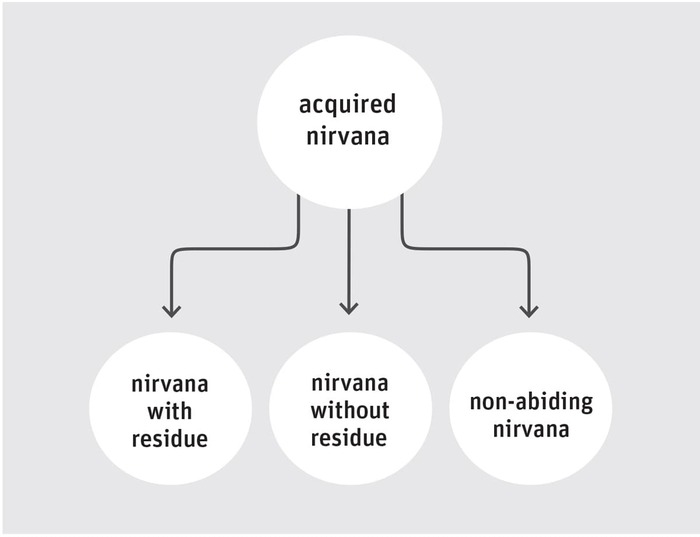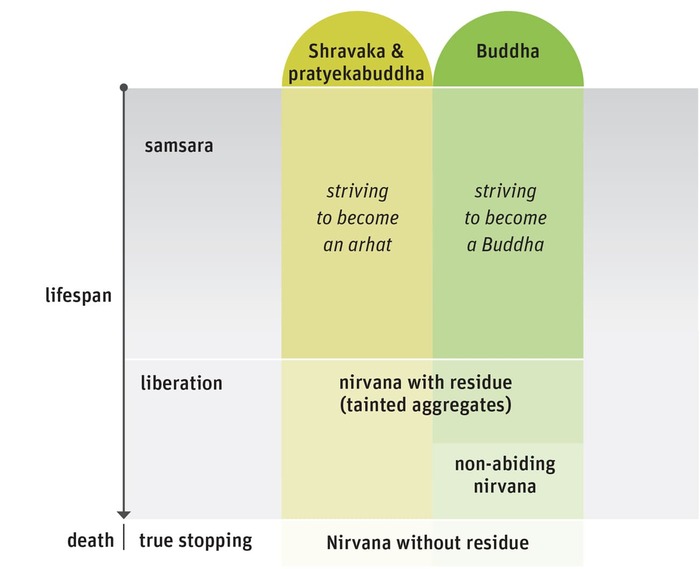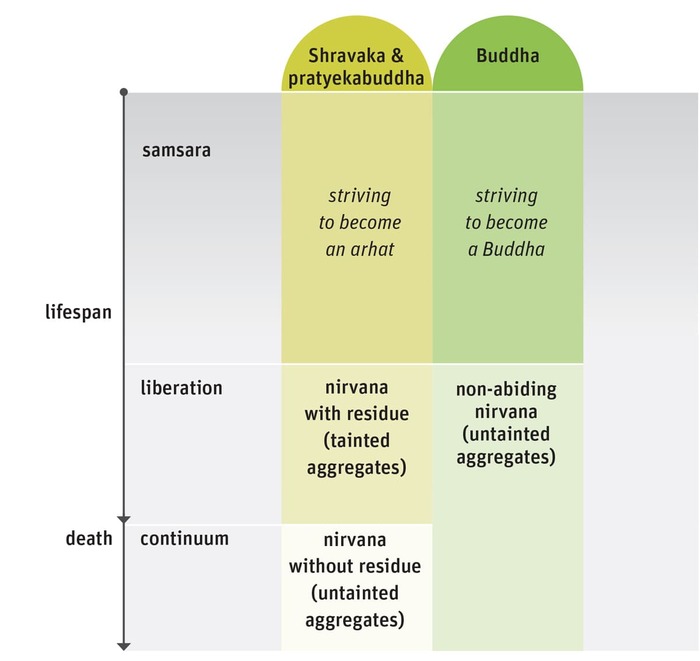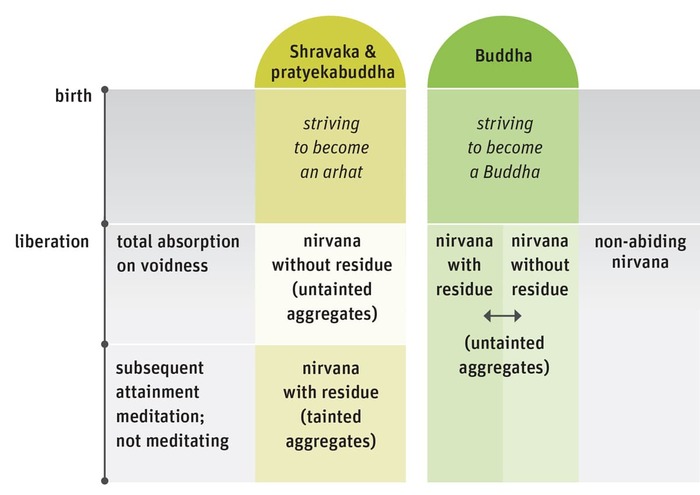The Meaning of the Word “Nirvana”
Nirvana (mya-ngan ’das, myang-’das, Skt. nirvāṇa, Pali: nibbāna) in Sanskrit and Pali means, literally, an “extinguished state.” The image is that of a fire that has been extinguished due to there being no more fuel. In its most common usage, the fire represents the sufferings of uncontrollably recurring existence (samsāra); while the fuel represents the disturbing emotions (nyon-mongs, Skt. kleśa, Pali: kilesa) and karma. The Tibetan term for “nirvana” has a different connotation. It means, literally, a “state beyond sorrow,” referring to a state of release from suffering.
Types of Nirvana
According to the Gelug explanation of the Prasangika-Madhyamaka tenet system, there are two types of nirvana:
- Natural nirvana (rang-bzhin-gyi mya-ngan ’das)
- Acquired nirvana (thob-pa’i mya-ngan ’das).
Natural nirvana is another term for voidness (emptiness), the actual way in which all things exist.

There are three types of acquired nirvana that are attained:
- Nirvana with a residue (lhag-bcas-pa’i mya-ngan ’das, Skt. sopadhiśeṣa-nirvāṇa, Pali: saupādisesa-nibbāna, kilesa-parinibbāna)
- Nirvana without residue, (lhag-med-pa’i mya-ngan-’das, Skt. nirupadhiśeṣa-nirvāṇa, Pali: anupādisesa-nibbāna, khandha-parinibbāna), also called parinirvana (yongs-su mya-ngan-’das, Pali: parinibbāna)
- Non-abiding nirvana (mi-gnas-pa’i mya-ngan ’das, Skt. apratiṣṭhitanirvāṇa).
The Hinayana tenet systems and, within Mahayana, the Chittamatra and Madhyamaka-Svatantrika systems do not assert a natural nirvana. It appears only in the Prasangika system, as explained by Gelug. Moreover, the Hinayana and various Mahayana traditions explain the three types of acquired nirvana differently. Let us examine a few of these traditions.
The Hinayana Presentation
According to the Hinayana tenet systems, as presented in Mahayana, one attains nirvana with a residue when, during one’s life, one becomes an arhat of the shravaka or pratyekabuddha class, or a Buddha. This is so called because there is still a residue left of one’s tainted aggregates (zag-bcas kyi phung-po). There is a tainted residue left because, unlike the Mahayana tenets, the Hinayana tenet systems do not assert anything untainted except true pathway minds (the fourth Noble Truth) and static phenomena, including true stoppings (the third Noble Truth). Thus, these systems do not accept that even a Buddha can have untainted aggregates.
[See: Tainted and Untainted Phenomena]
Upon death, an arhat or Buddha attains nirvana without residue, when the stream of continuity of his tainted aggregates is cut, like the extinguishing of a butter lamp. Then there is only a static true stopping (true cessation). These two types of nirvana, with and without residue, taken together, are called liberation (thar-pa, Skt. mokṣa, Pali: mokkha).
Non-abiding nirvana is the static unchanging state of full enlightenment achieved by a Buddha while he is alive. Because in this state, a Buddha remains neither in the extreme of continued samsaric suffering nor in the extreme of the passivity of a Hinayana arhat’s nirvana without residue, it is called “non-abiding.”

The General Mahayana Presentation
Although there is not total uniformity, from the general Mahayana point of view, only shravakas and pratyekabuddhas attain nirvana with a residue when they achieve arhatship during their lifetimes. They still have a residue of their tainted aggregates. “Tainted aggregates,” here refer to those that have ripened from samsaric causes. Upon their deaths from that lifetime in which they achieved arhatship, the shravaka and pratyekabuddha arhats achieve nirvana without residue. They no longer have tainted aggregates; however, their mental continuums do not extinguish like the Hinayana tenet systems assert. Their continuums go one with untainted aggregates – in other words, with pure bodies, residing mostly in Buddha-fields. Eventually, they will go on to the bodhisattva path. These two types of nirvana in reference to Hinayana arhats are still called “liberation.”
The terms nirvana with residue and nirvana without residue do not apply to Buddhas. Immediately upon their attainment of enlightenment, Buddhas have untainted aggregates. A Buddha achieves only non-abiding nirvana, still defined as remaining neither in the extreme of continued samsaric suffering nor in the extreme of a Hinayana arhat’s nirvana without residue.
[See: Physical Bodies of Buddhas and Arhats]

The Prasangika Presentation According to the Gelug Tradition
According to the Tibetan Gelug tradition, the Prasangika tenet system has its own unique way of defining the various nirvanas that are attainments. What a shravaka or pratyekabuddha arhat attains is still called “liberation” and what a Buddha attains, “non-abiding nirvana.” However, both of these are divided into nirvanas with and without residue.
With respect to a shravaka or pratyekabuddha arhats, nirvana without residue refers to their states during total absorption (meditative equipoise) on voidness, when there is no appearance-making of self-established existence (rang-bzhin-gyis grub-pa). Nirvana with residue refers to their state either during subsequent attainment (post-meditation) periods, when meditating on something other than voidness, or when not meditating at all. Because such arhats have not overcome the cognitive obstacles preventing omniscience, namely the constant habits of grasping for self-established existence, the appearance-making of such an impossible mode of existence recurs during such times. Thus, Prasangika is unique in asserting that, in this sense, nirvana without residue is attained before nirvana with a residue. Further, since Prasangika defines “tainted aggregates” as those mixed with an appearance of self-established existence, such arhats have untainted aggregates during their total absorption on voidness, and tainted ones at all other times.
When referring to a Buddha, however, such a distinction between nirvana with or without a residue in terms of whether or not there is the appearance-making of self-established existence does not pertain. A Buddha has overcome even the habits of the unawareness that leads to such appearance-making and is always in total absorption on voidness even while acting. Therefore, in reference to Buddhas, nirvana with and without residue are different aspects of their state of non-abiding nirvana. The former refers to a Buddha’s Corpus of Enlightening Forms (Rupakaya, Form Bodies) and the latter to a Buddha’s Corpus of Deep Awareness Encompassing Everything (Jnana Dharmakaya, Wisdom Dharmakaya).
